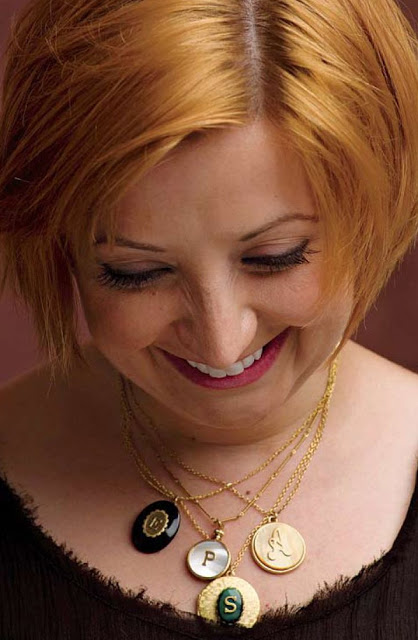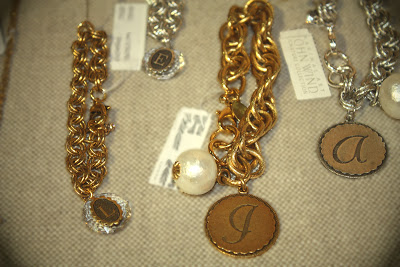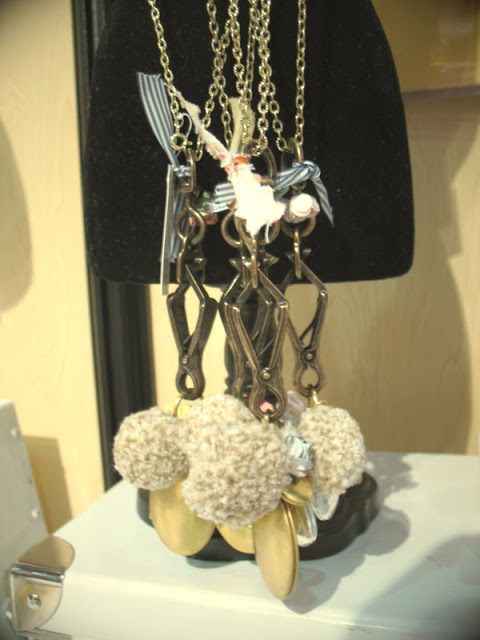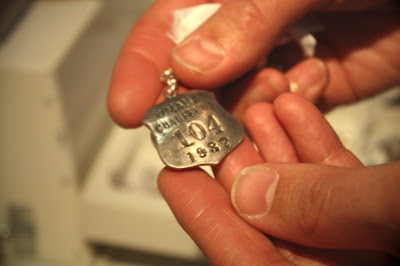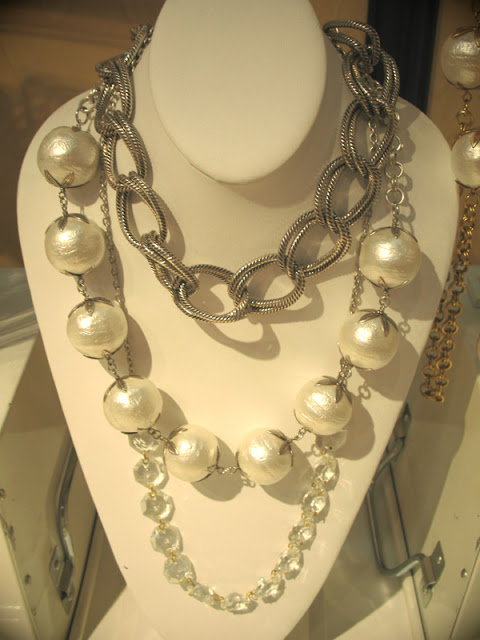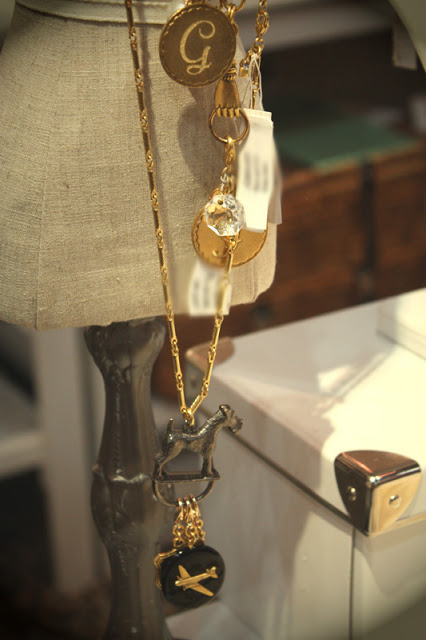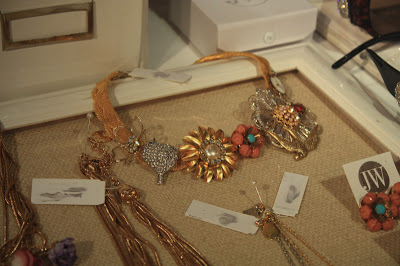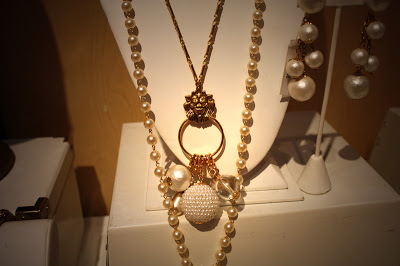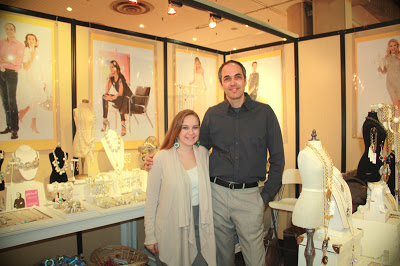Ever wonder the history behind the Anthropologie pieces you own? Besides the mass-manufactured items the store carries, there are also plenty of curiosities from smaller houses with deeper stories. Every so often I meet the artists behind the designs. This is one of those stories.
I met John Wind, founder of Maximal Art, during a trade show at the Javits Center in NYC. Mr. Wind has been creating jewelry for over 20 years and has had pieces at Anthropologie since the first store opened in Wayne, Pennsylvania.
Set up in one booth in a sea of thousands I knew right away I’d found the right booth once I saw the jewelry within. There was no question that many of the pieces fit right in with an Anthro lover’s style. Small lockets were adorned with crystals that recalled antique and Victorian designs. Dogs, lobsters and birds hung as charms from some chains, while cameos and beautiful resin presses dangled from others.
And then I saw them. The inital necklaces, in many different styles, all like the ones Anthropologie carried from 2008 to 2009.
“I remember these!” I said happily. I am in fact the proud owner of a “T” in the gold and crystal variety, and an “R” in the antique gold pressed version.
“These have a story to them,” Mr. Wind said, pointing to the large round pressed initials.
Intrigued, I dug for details. Mr. Wind was only too happy to share. A frequent flea market enthusiast, he heard about a World War II-era factory in Rhode Island that was about to be cleaned out. He and other scavengers headed there to look for salvageable and useful materials. Mr. Wind stumbled upon a set of typesetting samples from 1954. Small hand-carved metal presses formed a letter of the alphabet like a calligrapher’s delicate print. Each letter made a beautiful decorative initial, which in turn would make a beautiful necklace.
“They called it a handkerchief assortment of letters,” Mr Wind explained. “Meaning that they didn’t have every letter, just the letters commonly stamped on handkerchiefs. Only 18 or so. No Q, no X, letters like that were missing.”
Anthropologie commissioned multiple varieties of initial necklaces from Mr. Wind in 2008. They were of course interested in the incomplete set too. Which meant that he had to find a way to make the other letters — an incomplete alphabet simply would not do. Mr. Wind set out to finish the set. He and his design team designed the missing letters themselves and found a factory in the USA that could form metal presses from the designs.
A set that had been started in 1954 was completed in 2008. Come that December Anthropologie unveiled the initial sets in stores.
The initials sold well and Mr. Wind created another few variations for 2009. Many of his other pieces had their own tales of their own. I noticed a necklace that was part clip, part fluffy pom pom. Both pieces were inspired by flea market finds.
“To start I had one necklace in my design studio. One of Anthropologie’s buyers liked it and asked if I could make more. I told them of course, but inside I panicked a bit, because I had no idea where to get more of the clips!”
Mr. Wind and his team first tried to decipher what the clip was used for, hoping that would make their search easier. From nautical use to shipping to utility, the Maximal Art team dug for answers. After hitting a few dead ends they found out the clip’s true use: it was a dog training tool from Germany. Trainers would attach the clip to a dog’s leash. If the dog tried to pull, the clip made the leash tighter.
The true purpose now known, Maximal Art tried to purchase more. It turned out the clips were in high demand and nearly impossible to find. After plenty of no’s they finally found a company that had enough in stock to fill Anthropologie’s order. But that was just one part of the necklace.
The pom pom part of the necklace was made by treating yarn. It was not the kind of thing a factory could produce accurately. So Mr. Wind created a cottage industry of sorts — sourcing the material from a mill in South Carolina, and calling on friends to help him make the pom poms. From the suburbs of Philadelphia (where Maximal Art is located) to the boutiques of Brooklyn to friends dotted around the country, pom poms came from all corners of the nation. Eventually enough were made to fill the order and the necklaces were completed and shipped. It was a true group effort from all over the United States, from sourcing to production to completion.
Stories like this continued as Mr. Wind showed me more pieces. A reproduced chauffer’s medallion from 1937 that he found in Omaha (above). A turn-of-the century cameo and a tiny message in a bottle inspired by a flea market find (below). As each piece’s tale was woven they became more special to me. These aren’t some mindless charms produced in a factory overseas. They are salvaged and yes they are reproduced, but they have a history that is as much about the discovery as they are about telling their tale to our generation and the next.
Mr. Wind got his start in London while attending the Slade School of Art. He designed large brooches and jewelry pieces to wear clubbing and drew the attention of friends and boutique owners. Soon he had a small, successful business going designing pieces for independent stores and buyers. A high-end department store eventually came calling. Mr. Wind was not studying jewelry-making at school and the store initially rejected his pieces for not looking professional enough in construction. Instead of getting frustrated, Mr. Wind concentrated on bettering his methods. He learned how to add backs to brooches and how to bring pieces together without showing the signs of assembly. On his second try the high-end department store bought some of his line. Mr. Wind knew he’d found his calling.
Mr. Wind runs Maximal Art from just outside of Philadelphia, along with company president Robbin Cook. The company’s designs are carried in boutiques across America. For now the business is strictly wholesale, meaning individual buyers can’t buy directly themselves. Eventually Mr. Wind hopes to start an e-commerce store on his company’s website.
The company has over 20 employees and operates out of a warehouse-esque district. In the over 20 years of Maximal Art Mr. Wind has acquired an amazing library of product samples from his travels all over the world. The designs all start within company walls. I was impressed that almost all of his products are made in the USA. When a specialty material originates from another country, Mr. Wind goes straight to the source.
One example of this was a beautiful silver necklace adorned with large, pearlized beads. It turns out these were actually acrylic cotton balls created in Japan. Mr. Wind found a mom & pop shop making them, and while mass market versions are now available he stuck with a smaller company to create the balls he used. These were part of one of five or so collections Mr. Wind had in his booth. One of these necklaces is below.
I asked Mr. Wind where he thought jewelry was going next. He noted that there seems to be a return to the minimal adornment of the early 90s. At the Golden Globes, for instance, few starlets wore necklaces or large earrings. It was all about the dresses with a lot of naked necks.
“I’ve seen this before so I know it goes in cycles,” Mr. Wind said. “It was interesting to see how 2 years ago big statement necklaces were everywhere. And gold was making a comeback. Now silver is what the buyers want for their stores and smaller designs are more popular.
“The good news for me is that my shopper tends to like my jewelry no matter what the trend. So business is pretty steady for me. When my designs match up against the trends it’s a bonus for me. But I don’t design by trends.”
I noted that I’m really into watches right now — not so much in their classic style but as part of bracelets, or on necklaces. One of Mr. Wind’s recent designs was the Modern Master Watch, a functional watch attached to a pretty ribbon instead of a link strap. He agreed that watches were popular right now and hinted that he’ll be producing another style soon.
Besides the Modern Master Watch, a few of Maximal Art’s pieces are currently available at Anthropologie, including the Feather Lace Necklace ($48) and Feather Lace Earrings ($28). More pieces will be available soon and I’m hoping Anthropologie carries the initials again in the near future. (Hint, hint!)
Below are some additional images from Maximal Arts’ various collections. I’m thrilled to share the history of these fabulous items and look forward to seeing more of Mr. Wind’s pieces at Anthropologie.
If you’re an artist whose pieces are carried at Anthropologie, I’d love to interview you! Please have your representation email me.
Maximal Art contacts:
Rhonda Ryan PR/Social Networking Liaison – rhonda@maximalart.com
For retail information – info@maximalart.com
Shop Online – www.maximalart.com

